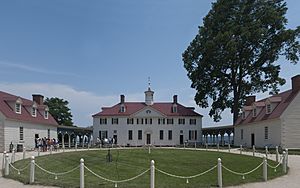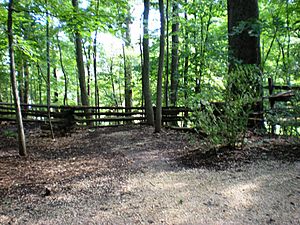Betty (slave) facts for kids
Betty (born around 1738 – died 1795) was an enslaved woman who lived during the time of Martha Washington. She was owned by the Custis family and worked on their plantation called the White House, located by the Pamunkey River in New Kent County, Virginia.
In 1750, Martha Dandridge married Daniel Parke Custis. When he passed away in 1757, Betty became one of the enslaved people Martha inherited. Martha then brought Betty to George Washington's plantation, Mount Vernon, after she married George Washington in 1759. Betty worked at Mount Vernon for the rest of her life.
Betty was also the mother of Ona Judge, who famously escaped from the Washingtons. Betty was a skilled seamstress, making clothes at both the White House and Mount Vernon plantations.
Contents
Betty's Early Life
Betty had a mixed background, with both European and African heritage. Because she was born into slavery, her mother would have been of African descent. This was due to a law that said if a mother was enslaved, her children would also be enslaved.
Betty was born around 1738. Enslaved parents worked long hours, so children like Betty were often cared for by others during the day. Before the age of twelve, enslaved children didn't have specific jobs. Instead, they did chores like collecting water or firewood, or helping to look after younger children.
Unlike adults, enslaved children often didn't receive shoes or blankets and had to share blankets with their families. They also received less food than adults. To get more to eat, families often grew their own small gardens. Betty likely had only one set of clothes for the entire year, which would have been simple shifts.
Life at the Custis Plantation
When Betty was a pre-teen, around 11 to 14 years old, she began training as a seamstress. This was a valuable skill that gave her a higher position among the enslaved workers at the White House plantation. Seamstresses often started work before sunrise and finished after sunset. Enslaved people who worked inside the house, like seamstresses, were often of mixed heritage.
As a seamstress, Betty made clothes for her owner's family and for other enslaved people on the plantation. The owner's family wore clothes made from nicer materials like silk or cotton. However, enslaved people's clothes were usually made from cheaper materials like linen or wool. Betty also had to repair clothes for everyone.
Betty worked closely with Martha Custis (who later became Martha Washington) at both the White House plantation and Mount Vernon. Betty was one of Martha's favored enslaved workers. While at the White House, Betty saw Martha deal with the sad loss of her first husband and two of her four children. She also witnessed Martha meet and marry George Washington.
While working at the Custis plantation, Betty had her first child, Austin, in 1757 when she was nineteen. Austin was reported to have lighter skin, and he later worked as a waiter for the Washingtons.
Moving to Mount Vernon
When Daniel Parke Custis died in 1757, Martha Custis became a very wealthy widow. As part of her inheritance, she received 84 enslaved people from the Custis estate. Betty, who was 21 at the time, might have been worried. When an owner died, enslaved families were often sold and separated to pay off debts.
Fortunately for Betty, she and her two-year-old son, Austin, were not separated. Martha Washington chose both of them to come with her to Mount Vernon in 1759. At that time, Betty and Austin together were valued at sixty pounds. Eventually, a total of 155 enslaved people from the Custis estate were brought to Mount Vernon. Even with the move, Betty likely still felt anxious, unsure how George Washington would treat her.
Daily Life at Mount Vernon
At Mount Vernon, Betty was part of the small group (about 6%) of enslaved people who were of mixed European and African descent. Betty spent her entire day working mainly as a seamstress and spinner. She also helped with cooking and cleaning. Since Betty worked in the Mansion House, the main part of the estate, visitors often saw her. Because of this, she was usually dressed better than enslaved people who worked in the fields. Betty wore simple, ankle-length dresses made from less expensive materials like linen or wool. She also had an apron, a cap, stockings, and shoes.
Just like at the White House plantation, Betty made clothes for her owners and for other enslaved people at Mount Vernon. She mostly used linen and wool for the enslaved people's clothing, following the specific amounts George Washington set aside for them. Betty had to make a certain amount of clothing each week, or she might have been punished.
It's not entirely clear where Betty lived at Mount Vernon. She might have lived in a log cabin or in a brick building called the "House of Families." This was the main living area for enslaved people at the Mansion House. Enslaved people who worked inside the house, like Betty, lived close to the Washingtons' home, possibly only 300 feet away. Only skilled, domestic enslaved people lived in the "House of Families." It was a two-story building with chimneys, located near the blacksmiths' shop.
Archaeological findings suggest that enslaved people living in the "House of Families" often cooked "one-pot meals." These meals usually included low-quality meat and cornmeal, along with any vegetables or fruits they grew in their own gardens. George Washington only provided his enslaved people with rations of pork and cornmeal.
Around 1792–1793, the "House of Families" was torn down. It was replaced by new one-story living quarters built nearby. These new quarters were large, about 2,800 square feet, and could hold sixty people in four rooms. Each room had a fireplace, a door, and some kind of bunk beds. Washington built these new quarters to keep a closer watch on the enslaved people.
The housing at Mount Vernon showed a clear social order. Skilled enslaved people often lived in brick buildings near the Mansion House. However, field workers lived in log or wood cabins on the different farms where they worked. Mount Vernon was made up of five different farms.
Betty had five children in total. As an enslaved mother, she was separated from her children for most of the day. She also had very little control over their lives. For example, George and Martha Washington chose Austin and Ona to go with them to New York and Philadelphia when Washington became President. Betty could not stop this, and her children were forced to be separated from her because they were Martha Washington's property. Every child Betty had added to the wealth of the Washingtons and the Custis Estate, as children and young adults provided more enslaved labor.
Betty's Later Years and Death
While her children Austin and Ona were working in Philadelphia, Betty continued to labor at Mount Vernon. She became a grandmother to eighteen grandchildren. Sadly, in 1794, her son Austin drowned while traveling back to Virginia from Philadelphia. This news was very hard for Betty to hear. Betty was already tired from her lifelong work as an enslaved person and had been sick.
She passed away at Mount Vernon in 1795, at about 57 years old. George Washington commented on her death, saying it was "happy for old Betty, and her children and friends, that she is taken of[f] the stage; her life must have been miserable to herself, and troublesome to all those around her."
Betty never escaped slavery and worked at the White House plantation and Mount Vernon her entire life. However, two of her daughters, Ona Judge Staines and Philadelphia Costin, did manage to escape and lived their lives as free women of color.



